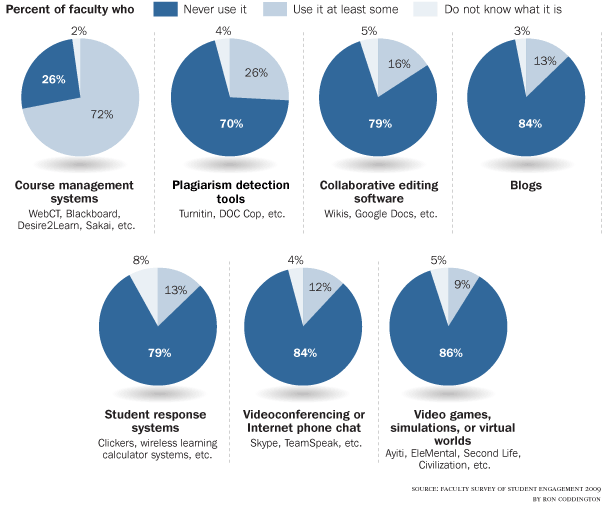Faculty use of technology: general faculty (chronicle of educ stats) and in teacher education (our stats)
A report from The Chronicle of Higher Education on faculty’s use of technology yielded the following data:
Image Source: The Chronicle of Higher Education; http://chronicle.com/article/Professors-Use-of/123682; June 25, 2010.
Discussion around these data include questions of whether technology makes a better teacher. Certainly an excellent question! We do not believe that using technology will magically make a teacher a better teacher – in fact, at first, many teachers (and university faculty) may face some hiccups as they learn to teacher in a more student-centered way, as many of these technological tools are best used by students to learn. Faculty do not experience hiccups when they adopt technology in support of the usual, teacher-directed pedagogy that we know very well.
We (Joan Hughes with Gloria Gonzales Dholakia, Yu-Chi Wen, and Hyo-Jin Yoon) have a book chapter currently under review called “The iron grip of productivity software within teacher education.” In the chapter, we discuss the importance of faculty modeling of optimal technology use for preservice teachers, as they learn a lot about what they will do as future teachers from what they experience in their teacher preparation program. Yet, we also describe productivity software’s (tools like PowerPoint, word processing, and spreadsheet suites) enduring grip as the most used digital technologies among preservice teachers during teacher education.
The Chronicle’s data (above) reminds us of the data we have collected from preservice teachers. Clearly, there’s ample room to discuss why productivity is emphasized so much (been around a long time, has affordances across disciplinary areas). But we believe an overemphasis on productivity tools is not adequately preparing new teachers for the knowledge society in which we/they live, work, and educate.
We are not faulting teacher education or PK-12 schools or preservice teachers. But we recommend that this focus will not change without concerted change efforts in both teacher education and PK-12 institutions because change in one won’t really have a ripple effect without simultaneous and complementary change in the other.
A glimpse into our data … reveals the high-use digital technology tools by student teachers in 2004-2007 were: email, presentation, search engine, web browser, word processing, and digital movies (student teachers are required to do a lesson study involving video recording their teaching). Overall, data from our student teacher respondents in 2004-2007 and 2008-2009 reflect a low, but emergent use of minimal Web 2.0 tools such as blogs, podcasts, wiki, and social bookmarking. We feel this is a positive trend toward better preparation of teachers to integrate technology into their future PK-12 teaching, but we feel a necessity for more emphasis and progress.
